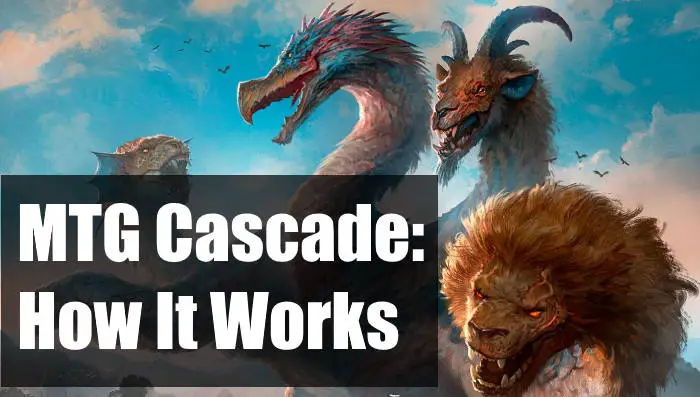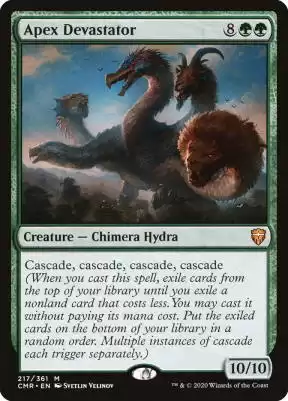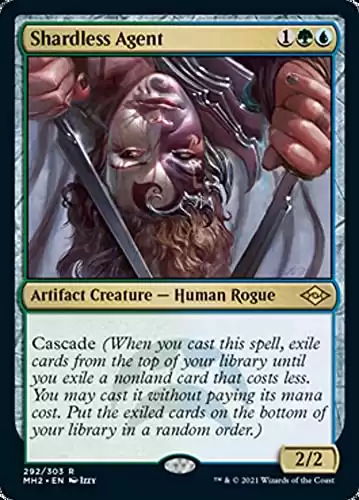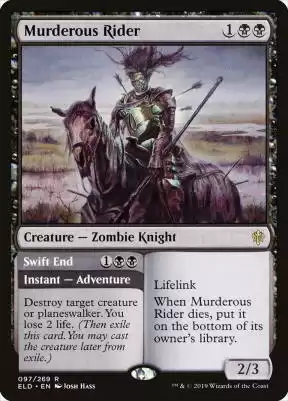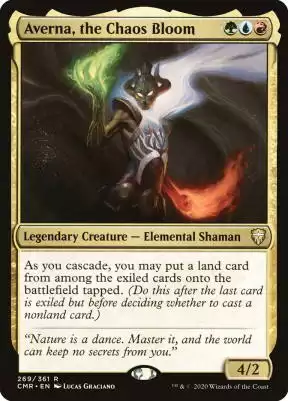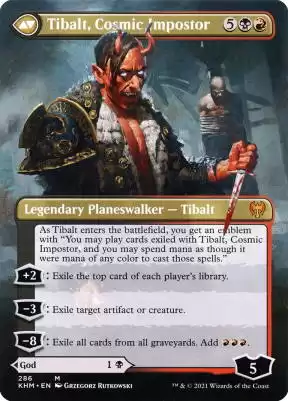Cascade is an MTG mechanic that seems simple but can get confusing really quickly. There are many niche interactions that test a player’s knowledge, and it can be hard to figure out the right answer. So how exactly does cascade work?
You exile cards from the top of your library until you hit a nonland card which has a lower mana value than the cascade card. You may cast that spell without paying its mana cost. Then, before resolving either spell, put any other cards exiled by the cascade trigger on the bottom of your library in a random order. Once both players pass priority, the exiled spell will resolve before the cascade spell does.
You can probably already see that just one cascade trigger can complicate the stack. Things get even more confusing when you add in multiple triggers or even other mechanics. Don’t worry, though: this guide will explain everything you need to know to use cascade in your next game of MTG.
Table Of Contents
- MTG Pros and Cons
- How Does Cascade Work?
- Is Cascade Good In MTG?
- Can You Make a Cascade Deck in MTG?
- Conclusion
MTG Cascade Pros and Cons
| Pros | Cons |
| Triggers on cast | Usually random |
| Gives you free spells |
How Does Cascade Work?
Before diving too deep into specific questions, let’s review the official rules text on cascade:
“When you cast this spell, exile cards from the top of your library until you exile a nonland card whose mana value is less than this spell’s mana value. You may cast that card without paying its mana cost if the resulting spell’s mana value is less than this spell’s mana value. Then put all cards exiled this way that weren’t cast on the bottom of your library in a random order” (702.85a).
MTG Wiki
Keep this definition in mind, as it will help us understand how cascade works in a variety of situations.
There are two big questions that come up with cascade: what happens when there are multiple cascade triggers, and what if an exiled card can be cast as different spells? Both of these questions have different answers in different contexts, so let’s dive into each.
How Do Multiple Cascades Work?
Some cards have mulitiple instances of cascade, and the most important thing to remember is that each trigger is separate.
If you cast Apex Devastator, for example, each of those triggers would go on the stack individually. This means that you’ll resolve them one at a time. If you choose to cast the spell exiled from the first trigger, it goes to the top of the stack and gets resolved before the other cascade effects.
This means that you can’t pick the order in which the exiled spells resolve since they’ll happen one at a time. When a card has more than one cascade trigger, you’ll resolve each one completely before moving onto the next.
What Happens If You Cascade into Cascade?
If you run multiple cascade cards, there is a chance that your cascade triggers could find another card with this mechanic. When this happens, you would cast the new spell and trigger its cascade.
In this case, the stack would look like this: at the bottom is the original cascade card. In the middle is the second cascade card which you cast from your first trigger. At the top, and the one that resolves first, will be the second cascade trigger.
To resolve everything, you’ll start with the cascade trigger, followed by the exiled spell (assuming you choose to cast it). Then, you’ll resolve the second cascade card, and finally resolve the original spell that you cast. As you can see, cascade can give you a ton of value, but it can also lead to very complicated stacks.
RELATED: What is the Stack in MTG and How Does it Work
How Does Cascade Work with Split Cards?
Some of the other mechanics in MTG can make cascade even trickier to use. In particular, cards that can be cast as two different spells can lead to a lot of confusion. As a general rule, you can still only cast one spell off of cascade and the mana cost is the combined cost of both spells. For example, you could cast Wear or Tear, but not both. Beyond that, you have to consider how each mechanic specifically works with cascade.
Split cards can be difficult to use with cascade because of how you calculate their mana values. According to the official rules:
The mana cost of a split card is the combined mana costs of its two halves. A split card’s colors and mana value are determined from its combined mana cost (709.4b)
MTG Wiki
As an example, Fire // Ice has a mana value of four, which means that you couldn’t cast it off of Shardless Agent‘s cascade trigger. Even though each half has a lower mana value than Shardless Agent, the spell you’re casting has to have a lower mana value when you exile it AND when you cast it (more on this later).
Also, it’s important to note that these cards have some restrictions based on where you’re casting them from. Notably, you cannot cast both halves of a fuse card from a cascade effect. You can only fuse a card when it’s cast from your hand, and cascade would cast it from exile.
With all of that said, you should still run split cards if they’re right for your deck. In fact, getting to choose which half of a split card you want to cast is pretty nice. Just keep these interactions in mind when thinking about potential synergy and lines of play.
How Does Cascade Work with Aftermath Cards?
Aftermath cards are another form of split cards, so they interact with cascade in the same way. Their mana value is calculated by adding the mana cost of both halves, so it can get quite high.
The other important thing to note is that aftermath has a similar restriction to fuse. The official rules state:
“You may cast this half of this split card from your graveyard” and “This half of this split card can’t be cast from any zone other than your graveyard” (702.127a).
MTG Wiki
Since you would be casting the spell from exile, you wouldn’t be able to choose the half with aftermath. You could still cast Spring, for example, but you couldn’t cast Mind.
How Does Cascade Work with Adventure Cards?
When a cascade ability exiles an adventure card, you use the creature’s mana value to determine whether or not you can cast it. This is because the creature has the “dominant” set of characteristics for the card. If the creature’s mana value is lower than the cascade card’s, then you would stop exiling cards and choose to cast either the creature or its adventure.
Once again, the adventure has to have a lower mana value than the cascade card. The adventure would also exile itself and allow you to cast the creature later, as it normally would. This effectively draws you two spells, one of which you get to cast for free!
How Does Cascade Work with MDFCs?
MDFCs or modal double-faced cards, work quite similarly to adventures. The front side has the “dominant” characteristics, so you would compare its mana value to the cascade card’s. Assuming it’s lower, you can then choose which side you want to cast.
Keep in mind that you can only cast spells, so no lands, and the back side must also have a lower mana value to cast it. Still, this interaction gives you choices, which is greatly appreciated for a random effect such as cascade.
Is Cascade Good in MTG?
Casting spells for free is one of the best things you can do in MTG, so Cascade is an exceptionally powerful mechanic. Perhaps its only downside is that exiling cards from the top of your library is usually a random process. Getting a spell for free can’t be too bad (especially since you thought the card was worth including in your deck), but this does make cascade unpredictable. Still, there are ways to mitigate this drawback.
First, you can limit the number of potential hits in your deck to just one unique card. If you only have one spell with a mana value lower than three, for example, you’ll always hit it off of Ardent Plea‘s effect. This can be a difficult deckbuilding restriction, but it can also lead to very strong play patterns.
Another way to add consistency is to run top deck manipulation. If you can put the effect you want right on top of your deck, then you can make strong plans instead of rolling the dice. Brainstorm, Ponder, and similar cards are wonderful for setting up these kinds of plays.
Of course, this method works best if you already care about the top of your library, such as in a Galea, Kindler of Hope deck. It could also be worth it in a deck with a high density of cascade cards.
Can You Make a Cascade Deck in MTG?
Since cascade is such a strong mechanic, building a whole deck around it could lead to a lot of wins. There are usually two styles of cascade decks: the first has lots of cascade triggers to get a ton of value, and the second tries to assemble a specific line of play. The latter could be trying to assemble a combo, or just looking for a specific card that it’s strategy is built around.
Cascade Value
In Commander, perhaps the most obvious choice for a cascade deck would be Averna, the Chaos Bloom. Temur is a strong color combination in general, and it also gives you access to a solid suite of cascade cards.
Averna’s ability to get you extra lands can be really nice, but it isn’t consistent. There’s no guarantee that you’ll exile lands on any given cascade trigger, and Averna doesn’t let you cascade more often. Still, this is a strong option for Timmys and Tammys looking for big, splashy plays.
Another great option is Prosper, Tome-Bound. At time of writing, there are only twelve cascade cards you can run in Prosper, so you probably can’t dedicate the deck solely to this mechanic. Still, there are some great cascade options, and the synergy with Prosper’s ability generates even more value.
Of course, these are just a couple of commanders that synergize well with cascade. Any deck that wants to have huge, explosive turns can benefit from the right cascade cards, so you’re by no means limited to these two.
RELATED: The Best Precon Commander Decks
Cascade Combos
As I mentioned earlier, knowing exactly what you’re going to hit off of a cascade trigger is really strong. Some decks are completely built around assembling these combos.
One of my favorite examples of this comes from a Commander’s Quarters deck tech. In his Maelstrom Wanderer deck, he runs just two nonland cards and 97 lands to ensure that he will always find his game-winning combo.
The deck isn’t perfect, since having one of the combo pieces countered will basically end the game for you, but it is very fun. It also illustrates just how strong cascade can be if you build your deck right (although it is an exaggerated example of this concept). You can find that video here.
Another example of this concept actually caused the rules around cascade to be changed. You used to be able to choose to cast either side of an MDFC (modal double faced card), even if the back half had a higher mana value than the cascade card.
Players used this interaction to exile Valki, God of Lies, but then chose to cast Tibalt, Cosmic Imposter. The ability to get such a strong planeswalker out on turn three made WOTC change the rules around cascade to what I’ve previously described. This shows just how strong cheating mana costs can be.
Conclusion
Cascade is among the most powerful mechanics in MTG. Getting free spells is a great baseline, and building around cascade can make it truly excellent. It can also just be tons of fun to start flipping cards off your deck and seeing what happens. Depending on what you’re looking for, cascade can add chaos or consistency to your deck, but you can always expect it to make a big splash at the table.
